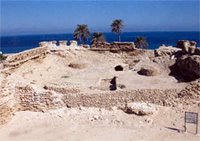Islamic, Sassanid, and Parthian Sites Discovered in Qeshm

Tehran, 3 March 2006 (CHN) -- Archeological excavations in Qeshm Island (south of Iran) led to the discovery of 32 historical sites belonging to the Parthian (150 BC–AD 226), Sassanid (226–650 AD), and Islamic (650 AD-present day) periods. Existence of abundant evidence from Islamic era is indicative of trade growth in this part over this period of time, in particular over the Safavid Age (1501-1736 AD).
In an interview with CHN, Alireza Khosrowzadeh, archeologist and the head of survey and identification team in Qeshm Island said, “Survey of different islands of Persian Gulf which have been started with the goal of identifying pre-Islamic sites led to the discovery of one Parthian site, one Sassanid site and 30 Islamic sites. ”He added, “These settlements have mostly been formed in this region for trade and business purposes, a fact which shows that Qeshm Island has been located in the trade route connecting the northern parts of the Persian Gulf to its southern areas.”
On the different processes of excavations in the Island, Khosrowzadeh pointed out that various historical periods from ancient time to the Islamic era, different kinds of defensive fortification and citadels built during the pre-Islamic era, and the special systems of water transfer and water storage during the warm seasons will all be investigated in this stage.
The largest island in Iran, Qeshm, is located in the Persian Gulf and covers an area of 500 square miles (1295 sq km). Qeshm Island is a mostly rocky and barren island with a small human population. On the little cultivated land there is, dates and melons are grown. Qeshm Island was once an important center of trade in the Persian Gulf region.

0 Comments:
Post a Comment
<< Home